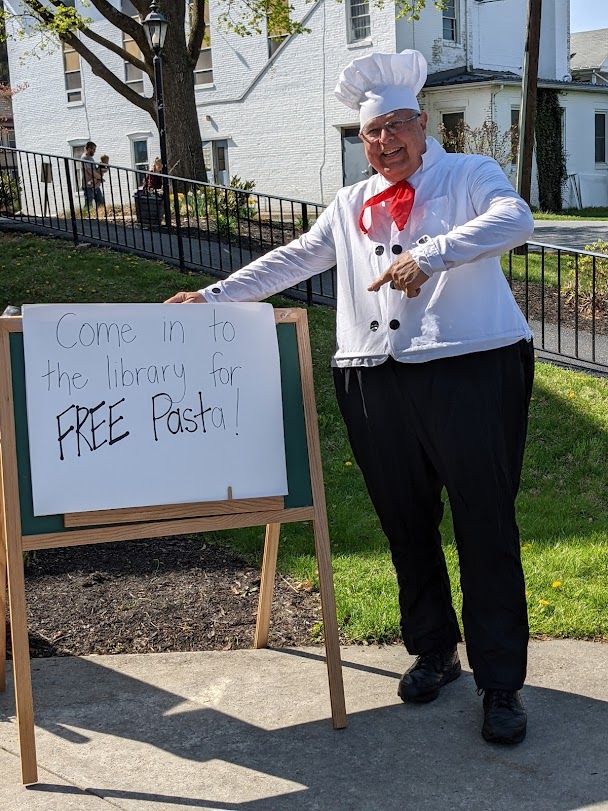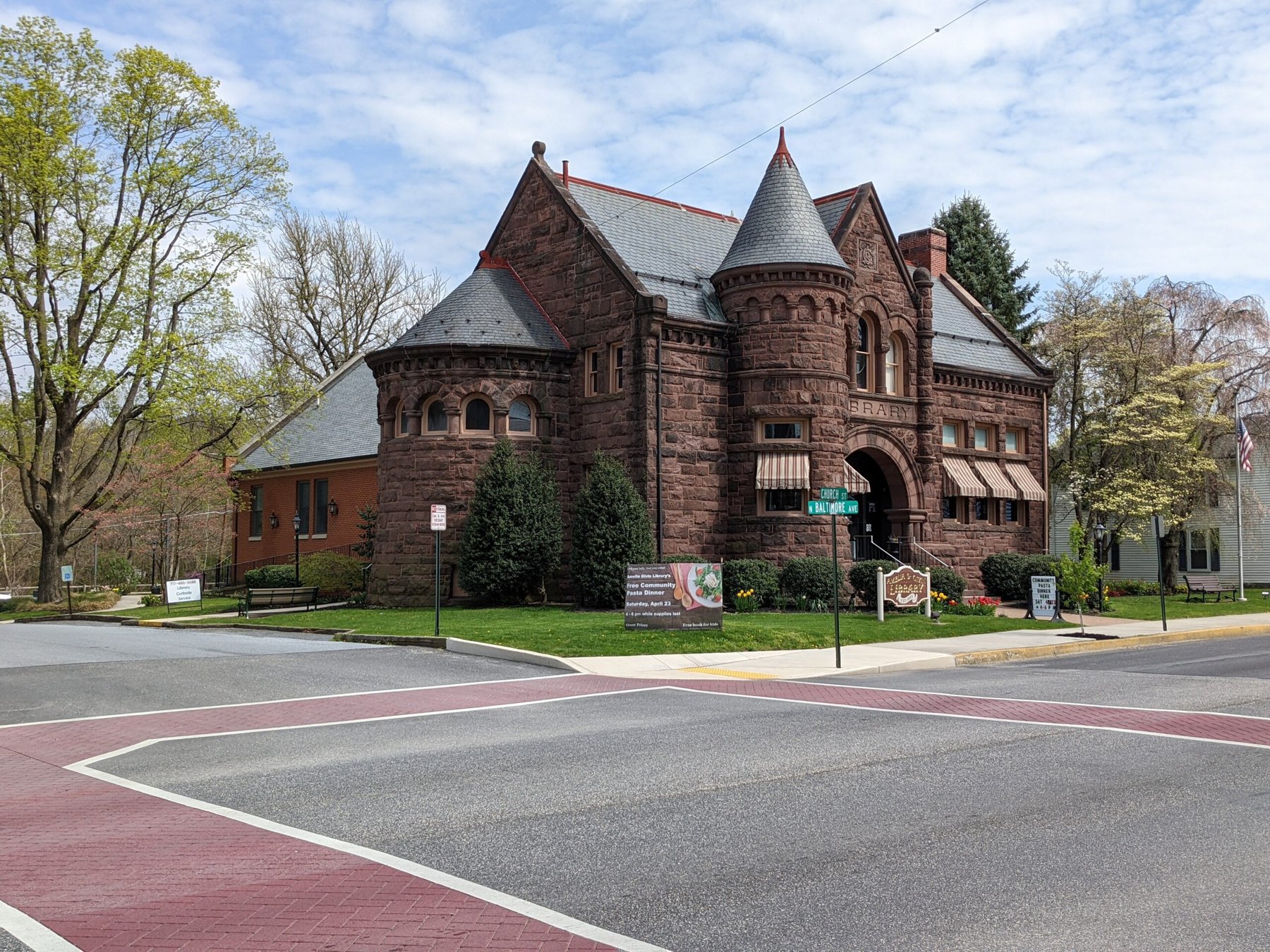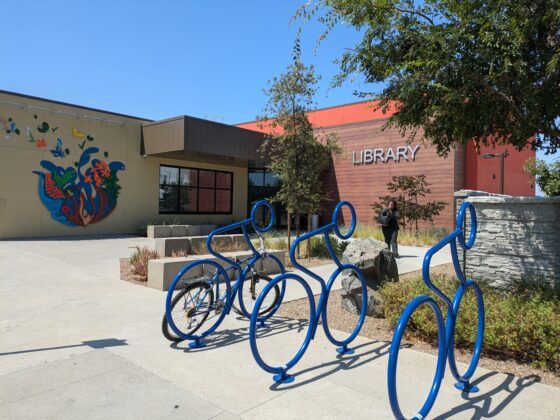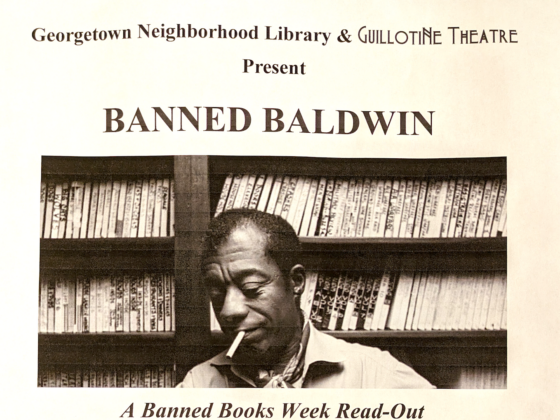Two of our favorite themes at Our Towns are public libraries and remarkable women. We have reported on dozens of inspiring public library stories, including the community librarians of Bend, Oregon and the civic-friendly library staff of Burlington, Vermont. We have stumbled across surprising 19th and 20th century heroines, including Eliza Tibbets, who singlehandedly started the Southern California navel orange industry, nurturing her first small trees with discarded dishpan water in 1873; Jerrie Mock, a modest housewife from Columbus, Ohio who became the first woman to fly solo around the world, even as the world continued to search for Amelia Earhart; and Isabella Greenway, who was a close friend of Eleanor Roosevelt, a serial business entrepreneur, a partner with her husband creating the copper-mining company town of Ajo, Arizona, and the first woman to represent Arizona in the U.S. House of Representatives during the New Deal.
During our recent visit to Mt. Holly Springs, a tiny Pennsylvania borough of 2,000 people some 25 miles north of Gettysburg, we discovered a perfect storm of these two themes in the person of Amelia S. Givin, who built and funded the first public library in Mt. Holly Springs not 20 years after Eliza Tibbets was nurturing her orange trees.
Amelia Givin was the only daughter among the five children of Robert and Sara Givin. In the mid 19th century Robert Givin and his brother had founded the successful and lucrative Mount Holly Paper Company, in this manufacturing-intensive region of southern Pennsylvania. The mill brought jobs and opportunity to the area, including for a community of African Americans who moved north after the Civil War. It also brought prosperity to the town and great wealth to the Givin family.
Robert Givin intended that one of his sons would eventually take over the mill. The family had a male “heir and three spares” to work with. But one by one, the young men died, some in circumstances that remain opaque, I was told. That left Amelia, age 33 when her father died suddenly in 1879, to pick up the mantle and run the company.

Givin became a successful businesswoman and added European travel and philanthropy to her portfolio. Within a decade of assuming newfound responsibilities at the mill, Givin took the particularly progressive step of designing and building a free public library for the residents of Mt. Holly Springs and the employees of her family mill. She also took responsibility for stocking it with books.
The public library movement, moving beyond the for-pay subscription libraries, was beginning to take hold in the last half of the 19th century in the U.S. Andrew Carnegie was beginning to fund American public libraries about the same time Amelia Givin was building her library. Givin had vision and passion to broadly share her love of books, and built in little Mount Holly Springs an extraordinary, dramatic building, especially for the era and for that part of the country.
Givin hired pre-eminent Pittsburgh architect James T. Steen, an acolyte of the renowned Henry Hobson Richardson, to design her library in the grand style that became known in the late 1800s as Richardsonian Romanesque Revival. The heavy brownstone used in the building came from the Pennsylvania quarries.

Today, more than 130 years after its construction and dedication in 1890, the Amelia S. Givin Free Library, remains stunning, with high arch-topped windows and intersecting gables of its dark slate roof. The entryway opens onto a reception room with the front desk and three reading rooms to the sides. Each of the four main rooms has a fireplace, each with different and distinct colors and patterns of tiles that Givin probably spotted during her travels. When the library director, Cynthia Thompson, showed us around the library this spring, she said that the green tiles in what is now the computer room were her personal favorite. She also said that the tiles, still nearly perfect, are likely worth a hefty sum today, at least according to Antiques Road Show where she had spotted similar ones. I especially liked the blue tiles, watched over and seemingly guarded by the stern, imposing portrait of Amelia Givin, which hangs above the fireplace in one of the front rooms.
Amelia Givin’s showstopper of her 19th century library is the fretwork. Fretwork, as we learned, is ornamental design of intricate, geometric patterns, in this case fabricated of wood in interwoven spirals. In Mt. Holly, they are framed to serve as partitions, walls, and doors throughout the library. Visiting the library today to see and learn about the fretwork, as many people do, we stood in the front rooms of the building and found ourselves peering from one room to the other through the 10-foot fretwork partitions among the four main rooms, or seeing the sunlight over the high panels.

When nearby-Mt. Holly resident Paul Tucker, a woodworker, carpenter, and now self-taught expert in Moorish fretwork first walked into the library and saw the woodwork, he told me that he thought, I can’t believe my eyes. Tucker could see that the fretwork wasn’t made of steam-bent willow, as someone had told him. He said, “I looked at the spirals and could see that the wood graining went straight through.” And he concluded the fretwork had to have been machine-made.
That observation launched his investigative work of the fretwork origins and Givin’s likely role. Poring over every square inch of the fretwork, Tucker spotted an 1885 brass patent tag that led him to the Maryland Patent office. He traced that to the name of Moses Y. Ransom, fabricator of the fretwork, in Cleveland. Also, Tucker learned that J.T. Steen’s architectural firm in Pittsburgh had been across the street from an interior design company that featured some of Ransom’s fretwork ornamentation. All this led Tucker to wonder if Givin perhaps found inspiration for the fretwork during a visit to her architect. Or perhaps she saw an advertisement for fretwork in one of the magazines of the era, which she could likely have read. Much remains a mystery.
Givin was a participatory philanthropist. Every single person I talked with about her told me the same story: Givin would often ride up to the library in her carriage, excuse the librarian to take some time off or even a ride in her carriage, and then step behind the front desk. She enjoyed working in her own library.
Givin’s legacy at the library is personal. Thompson told me that she has often asked herself, “What would Amelia think about how things are today?” Today, the library has made its way into the 21st century. Like all successful libraries, it bustles with activities. But also like nearly all of today’s public libraries, the Givin library struggles to keep programs going and staff paid. When state funding was cut drastically in 2007-2008, the library board had a Sophie’s choice of sorts. They cut back hours significantly for most of the staff, but made the children’s programs a priority. Funding is inching back, but Thompson told me, “Funding issues are what keep me up at night.”

Earlier, in the late 1980s, the library added space for a children’s section, stacks, and a basement public meeting space. While visiting Mt. Holly this spring, we lucked into a Saturday afternoon event in that meeting space. You could call it an awareness-raiser — a free pasta dinner for the community and people like us, who happened by. Volunteers brought the homemade dishes, and the church next door served as a staging area. Mt. Holly’s mayor, Brian Robertson, gamely decked out as an Italian chef with a hoop-extended white shirt, red tie, and chef’s hat, waved his placard, Progressive Insurance-commercial style, grabbing the attention of anyone driving by the library on busy Baltimore Avenue. It made for a jovial, high-spirited meal with a few dozen volunteers and diners, and with animated conversations about local conservation rules for the area streams.

Courtesy Jim Burgess.
Mt. Holly Springs, like many other towns, uses the library to bring the community together to acknowledge its past and reinforce its sense of place. The library earned its own place in the National Register of Historic Places in 2004. They have applied for a Pennsylvania historical marker. In 2016, a collaboration among the library, the Carlisle Area School District, and the Cumberland County Historical Society launched a community-driven project for school children to promote local history and the people who made it—in this case the story of the remarkable Amelia S. Givin. Local volunteers staged reenactments and dressed the part. Kids and families came to show off the elementary school students’ research projects at the library.
Since then, the Givin event has lent inspiration to the Remarkable Women series, one of the Mt. Holly Community Heart & Soul (CH&S) initiatives to recognize and celebrate women from the area. As Jim Burgess, a Carlisle Area School District teacher and principal for more than 25 years and now community leader in area CH&S projects, told me, a number of activists remarked that there was plenty of local history documented about men in the area. But the women were always mentioned as Mrs. So-and-So. They decided to give the women, remarkable in their own right, some due. Jim Burgess is working on a project featuring Harriet Gumby, who was the storyteller of the Mt. Holly AME church project we reported on. Pam Still, an activist with many community organizations, is researching Remarkable Women from the 1700s, 1800s, and 1900s.
Community Heart & Soul®, a nationwide organization that supports local resident-driven community efforts, and is also a supporter of Our Towns, has a big presence in Pennsylvania. Several towns in York and Cumberland Counties — Carlisle, Mt. Holly Springs, and Dillsburg — all have local organizations of CH&S, and have cross-fertilized to their common advantage. Further expanding this regional footprint is a unique collaboration with the statewide organization, PA Humanities. All 14 CH&S towns in Pennsylvania are supported in part and encouraged by PA Humanities, which has made civic engagement one of its mainstays.
PA Humanities has wrestled with clarifying its mission without sounding programmatic and un-human. The clarifying moment, Jen Danifo, Senior Program Officer of PA Humanities, and Laurie Zierer, Executive Director of PA Humanities, told me, arrived in a conversation with staff from CH&S, PA Humanities, and the National Endowment of the Humanities, all heavy hitters. They realized the shared essence of their work is about making the human connections, and is focused on the people and what they do together. They established a natural, powerful connection.
This is an example of regional efforts expanding into being something bigger than the sum of their parts. Our Towns has seen this in eastern Tennessee, with a variety of region-wide programs including new local scholarship support from Tower Community Bank; in western Virginia and North Carolina with the Danville Regional Foundation; in inland Washington state and Idaho, with the Innovia Foundation and their new Launch NW scholarship promise. These are just a few examples of how regional collaborations punch above the weight beyond what any single community could do on its own.




